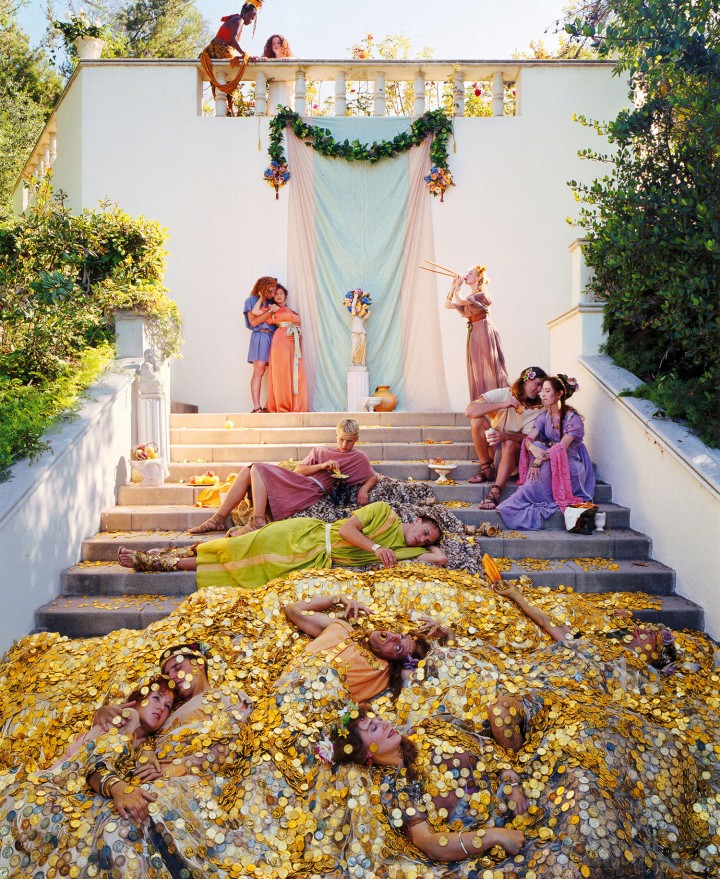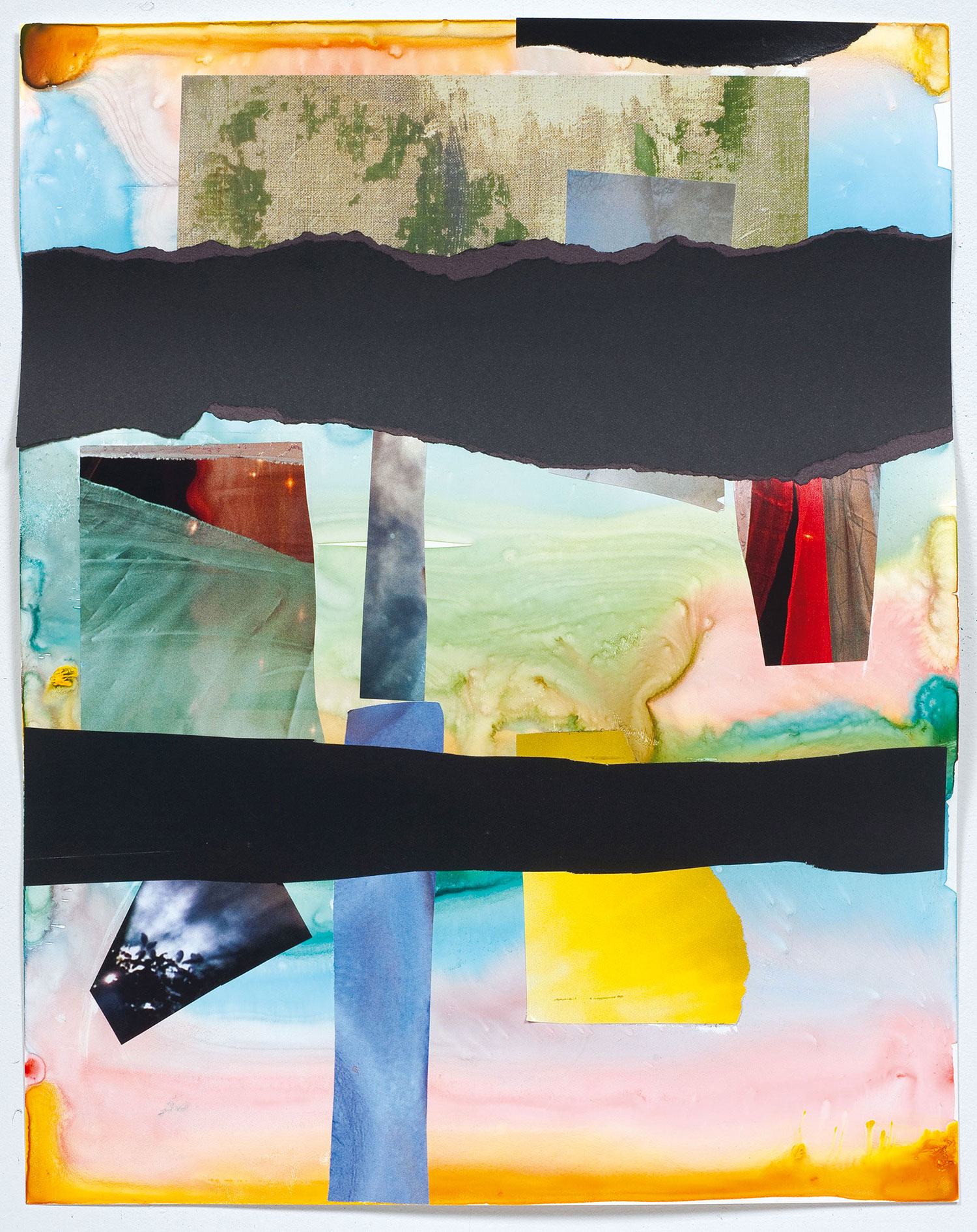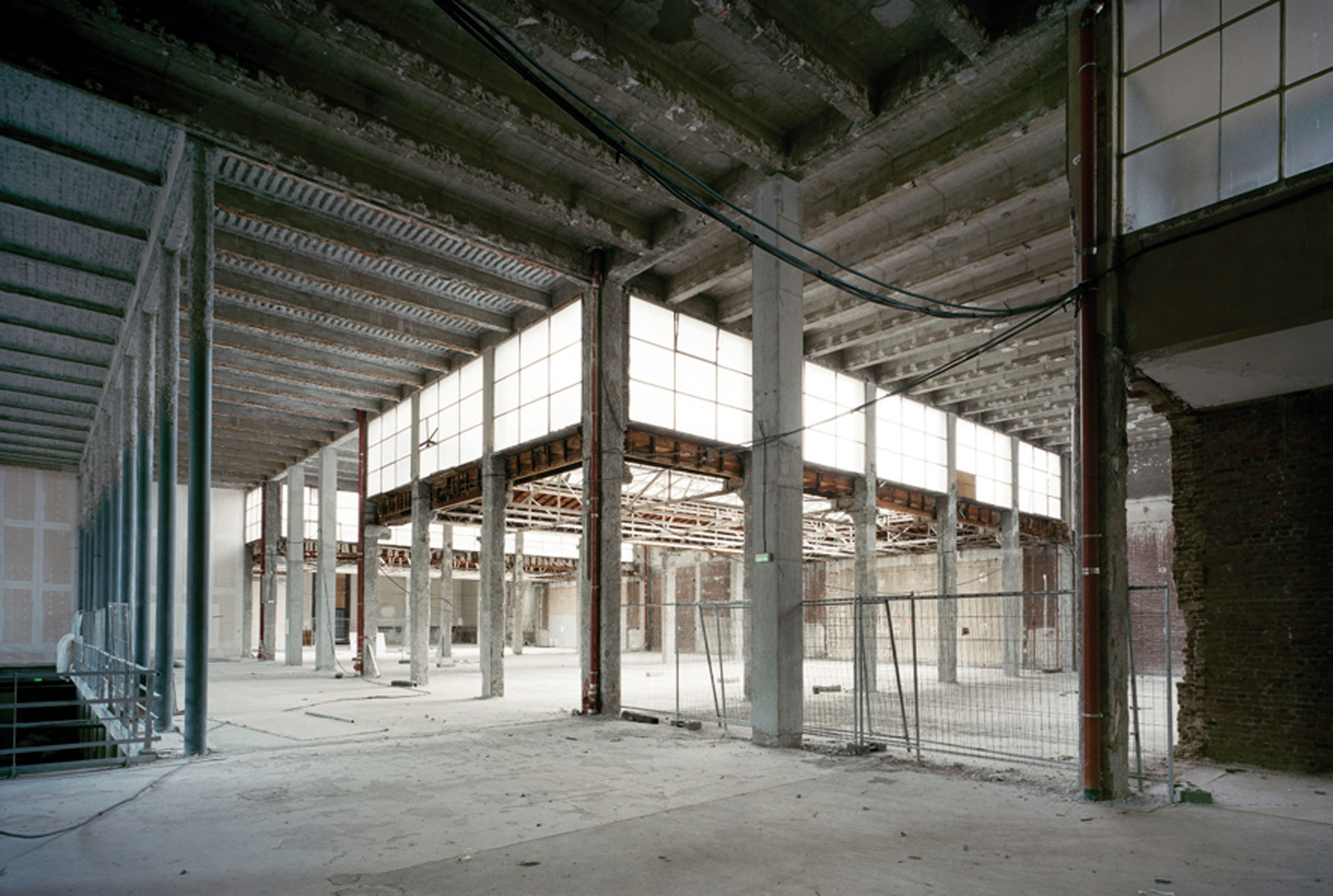
Glenn Phillips: Both of you grew up in different parts of the United States — Judy you were in Chicago, Eleanor you were in New York — and you both came to Los Angeles in the ’60s as young artists. What was your impression of LA?
Judy Chicago: I came in 1957 to go to UCLA. I remember getting off the train at Union Station and seeing all these low-level white buildings that seem to levitate. UCLA was filled with eucalyptus and oranges trees, there were not that many buildings, and the sky was blue. I graduated in 1964 and started teaching part time at Irvine. Los Angeles was like a paradise, a very different place from now. And it was also very cheap to live; one could live on 400-500 dollars a month, included renting a big studio for work.
Eleanor Antin: I came here ten years later. I remember looking down from the plane and seeing the pools… thousands of endless light-blue kidneys! I then went to San Diego since my husband David had a job there. We both desperately wanted to leave New York. It had been an incredibly exciting time to be in NY and we had good friends among the minimalists, the Pop artists, the members of The Judson Theater… but after a while we started to get bored. Allan Kaprow suggested asking David to run the UCSD gallery in San Diego — the one that became the Center for Music Experiment. So we decided to move here with our one-year-old kid. We arrived the day Robert Kennedy was assassinated, and just 24 hours before that Andy Warhol and his Italian friend Mario Amaya had been shot by Valerie Solanas.
Patrick Steffen: It seems like it was a dangerous time in the United States, especially for an artist.
EA: It was a dangerous time for everybody. Martin Luther King had also been shot one month before. It was a strange time, in some ways not unlike ours today…
JC: It was a difficult but exciting time to be a female artist; it was just the beginning of the feminist art movement. I remember having read Valerie Solanas’s SCUM Manifesto and I couldn’t believe that she was really saying all that. It was a complete taboo in those days!
GP: Were you still in touch with the art scene in NY?
JC: I took a year off from school and lived in New York from 1959 to 1960. I saw all the early Abstract Expressionist works. I was certainly aware about what was going on in New York, but I was showing here in Southern California. I came up here as a student and it was here that I tried to formulate my first ideas.
EA: I was still connected to New York through the galleries. But I quickly got involved with the feminist movement through Suzanne Lacy and Arlene Raven, and I began doing performances for audiences for the first time at the Woman’s Building in 1973. One day, Craig Kauffmann asked me if I wanted to teach at UC Irvine, and I taught there for two years, before going on permanent faculty at UC San Diego for 30 years. Bas Jan Ader was at Irvine too… When we left for the summer, I asked Bas Jan if he was coming back in the fall. “I’m doing this piece, I don’t know, I hope so…” I didn’t know what he meant. So we shook hands and said goodbye. I never saw him again.
JC: One of the things that your story suggests is how much more open the universities were at that time, which was why it was possible for me to start the first Feminist Art Program at California State University, Fresno. Now university art programs are much more rigid; there is more competition and a lack of reciprocity.

GP: The university programs in Southern California were extremely open, but I don’t think that affected how hard it was for a woman to just get a show. Eleanor, I have been looking through your archives, which the Getty Research Institute has just acquired. I was surprised by how much you struggled to get a show…
EA: That’s why I wrote a lot of nasty, bad letters to people who didn’t include my work in their shows. I loved to do it! And I wrote nasty letters to schools calling them “sexist pigs”!
JC: I would have never thought to do that, even though I’m also a writer!
EA: I considered myself a conceptual artist and I guess I still am one, but I had a much broader idea of what that meant, and I was also totally into narrative, which was not a popular thing at that time, and theater was at the core of my work. I just followed my own voice. My work was filled with feminist implications, and did not look like Joseph Kosuth or Dan Graham. Maybe it looked more like John Baldessari in some ways because of the comedy. In my Domestic Peace project (1971), I looked totally nuts to gallerists! Michael Sonnabend took the time to explain to me how insensitive my line was, and he showed me a drawing by Jasper Johns. “Now, there’s a line,” he said. I thought he was going to cry.
PS: Judy, you did not write bad letters, but you destroyed your work.
JC: I destroyed my early works for a few reasons. I had many troubles in graduate school. They all loved the yucky colors, influenced by the Rico Lebrun’s aesthetics: ochre, yucky green. I started as a painter and moved into sculpture because my male teachers hated my ivory, turquoise and pink color sense. They also hated my kind of naïve proto-feminist imagery. So I destroyed all those paintings. Ultimately, I ended up with a double masters degree in painting and sculpture. Then when I got out of school, I excised any hint of gender from my work and started doing big minimal sculptures. But I was young and out of the loop. For instance, I had no idea that when my piece Rainbow Pickett (1965/2004) was in the “Primary Structures” show in New York, that I should get on the plane and go to the opening. And then I started to work on all these blown domes, and one day I asked Irving Blum to come over to see them. All he said was: “Oh, the Venus of Willendorf!” My content was completely unacceptable. And I destroyed Rainbow Pickett because of Walter Hopps, who used to visit studios. He broke my heart by refusing to even look at it.
GP: Let’s talk about history, since it’s such a big part of your work. Judy, your work is about reclaiming history and shifting emphasis, whereas your work Eleanor is about taking history into your own hands and rewriting it in a way that better suits your imagination.
JC: I don’t think that our impulses are different; they are just two different manifestations. For me, it has to do with trying to integrate within my work the historical information about women that has been erased from history — unfairly.
EA: I was really brought up with history. I had this incredible connection to Yiddish culture and Bolshevism, both of which were just about gone by then. I was brought up with a passion for Russia. It was the center of my mother’s life. She had been an actress on the Yiddish stage in Poland and she was an ardent Stalinist. I was always taking dance and art lessons, and I loved every moment of it. You know, I’m a romantic, and there is always a melancholy at the core of history because it’s gone. Even if it’s funny — I keep seeing the irony in the comedy — it’s a sort of Jewish thing. Laughter and tears, pathos and comedy.
JC: I also come from a leftist background, and my father’s passion for history gave me the idea of looking into history to see if it was correct that women had made no contributions to history, which is what I was taught in college. Moreover, at that time, there were almost no women in the museums or galleries!
EA: Women were not in the books. I remember having read the Goncourt brothers’ French Eighteenth-Century Painters (1859-1875), and Vigée Le Brun was not there for instance.
JC: That’s exactly what I meant by women’s history being erased. To some people, history can be intimidating, but I was raised with the idea that the world could be changed.
GP: We take for granted that male artists experience competition as a part of what they do. But I certainly see a lot of competition between female artists today. What is your experience?
EA: Is competition so important? I came from New York where it was a very hot scene. Those people were so competitive with each other, but for me that wasn’t the point. When the feminist scene started here in California it was very supportive, a different approach.
JC: When I was a young artist, whenever I was treated badly, I assumed that it was because I was a woman and, to some degree, that was true. However, it never crossed my mind that the male artists were sometimes treated just as badly simply because they were artists. It took me a long time to realize this. I was a very naïve, idealistic young woman, and when I hung out with the guys at Barney’s Beanery, I was horrified as they were so incredibly competitive with each other. I always believed that a group should be supportive! When I decided to make a radical change in my art making and set out to figure out how to build a feminist art practice, I brought a set of values, about collaboration and support, and that was very different from what seemed to be acceptable in New York among both women and men artists. That’s probably one of the things that destroyed my relationship with Miriam Schapiro: she was really competitive and she couldn’t even imagine another kind of relationship. Then, in 1979 when The Dinner Party entered the world, there were some people who could not deal with a work of art based on feminist principles: support, collaboration, acknowledgement and providing space to everybody. It was a completely different paradigm, and it has always been my commitment — in my studio and in the world.

EA: I think that The Dinner Party (1974-1979) is one of the major performance pieces of our time. That’s how I see it, as a performance.
JC: Thank you!
EA: My view of the New York scene was so different, maybe because I was forming as an artist, so I didn’t notice these things. But the nastiest thing that was done to me was done by a woman. It was during the days of 100 Boots (1971-73). I was in New York visiting the galleries. I was chatting with Carl Andre who was also visiting that gallery, and this woman walked in. She was a conceptual artist, and she turned away from me as soon as she saw me! Carl introduced us but she refused to talk to me and fawned all over him! It was Lee Lozano, and I didn’t know then that she was doing her lifelong project Decide to Boycott Women, refusing to talk to women again for the rest of her life. But I only learned this at the “WACK!” exhibition years later, when the scenario for the piece was exhibited. I realized then that I had been an unwilling part of an artwork she began in 1971 that ended up continuing for 27 years. It was a very nasty, horrible (though interesting) work, and I was one of the victims!
PS: Let’s close our conversation with the present moment. Pacific Standard Time is the event that has somehow made this conversation possible since you are both intensely featured in many shows. What does PST mean for you?
EA: It is an extremely important event. I rediscovered some fascinating works, especially in the exhibitions “Under the Big Black Sun: California Art 1974-1981” at MOCA and the “State of Mind: New California Art Circa 1970” at OCMA. It’s important to portray the originality that is California — the freedom, the openness that we have here. I think the fact that we are challenging the hegemony of New York, or of what New York was, is very important. We have distinctive voices here and it’s important that they be historicized. And on a more personal level, I rediscovered the work by the “plastics boys.” I saw the show “Pacific Standard Time: Crosscurrents in Los Angeles Painting and Sculpture, 1950-1970” at the Getty, and they looked so good! I used to be pissed off about them and I considered them the enemy…
PS: Why did you consider them as your enemy?
EA: They were the ones that were shown all the time in the Los Angeles galleries and museums, but when you read interviews with them now, apparently they felt unappreciated, and this is hilarious! Because at that time I thought that they owned the entire world and we, the new media and conceptual artists, were the ones who were stepped on!
JC: PST will be truly successful if it challenges the mainstream male-centered narrative of contemporary art. But it’s too soon to say if that will happen or not. Certainly, what we have seen so far in PST is that the work that gets into the mainstream institutions and galleries is not always the best work. I personally have very strong feelings about PST. After The Dinner Party was permanently housed at the Brooklyn Museum, my whole career tended to go east; my archives are there as well as a number of collections of my work. As a result, my California roots were being erased. Even though the Los Angeles art scene of the ’60s and ’70s was terribly inhospitable to women, still there was a spirit of self-invention that allowed artists like me (and others who don’t fit into the mainstream narrative) to flourish. And I’m very grateful that PST has begun to disrupt the idea that the only work I ever did was The Dinner Party. I know from studying women in art history that it’s common for women’s production to be narrowed down to one piece in terms of perception. PST is changing that for me, which I’m glad.





